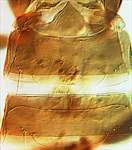Generic diagnosis
Medium sized, usually macropterous Idolothripinae. Head about as long as wide or longer; postocular setae elongate, ocellar setae usually short; genae often with stout setae; eyes moderately large. Mouth-cone short and rounded; maxillary stylets usually V-shaped, retracted to middle of head. Antennae 8-segmented, segment VIII usually long and slender; III with 1 or 2 sense-cones, IV with 3 sense-cones. Pronotum transverse, shorter than head; notopleural sutures complete or incomplete. Prosternal basantra present, ferna and mesopresternum well developed; metathoracic sternopleural sutures present. Metanotal median setae usually elongate. Fore tarsal tooth present in male, present or absent in female. Fore wings, with or without duplicated cilia. Pelta usually triangular with small lateral wings; tergites II–VII each with a pair of well-developed sigmoid wing-retaining setae. Tube straight-sided or with apex sharply constricted; anal setae shorter than tube.
Nomenclatural data
Gastrothrips Hood, 1912: 156. Type species Gastrothrips ruficauda Hood, by original designation.
This genus of 38 species is widespread in tropical countries (ThripsWiki, 2022), with a single species found in northern Australia.
Australian species
Gastrothrips acuticornis (Hood, 1925: 65).
Relationship data
This is the only genus recognised in the Idolothripinae, Pygothripini, Gastrothripina. The species are unusual in having only three sense cones on antennal segment IV, a character state that is shared with Cryptothrips species. The only named species recorded from Australia has antennal segment VIII long and slender, but several unidentified species have also been seen with this segment short and broad.
Distribution data
The only member of this genus known from Australia was described originally from the West Indies. It was subsequently described under three different names from Hawaii, New Caledonia and Queensland, Australia, where it is widespread north of the Queensland/New South Wales border. A few specimens of a further unidentified species are available in collections.
Biological data
The species of this genus all feed on fungal spores on dead branches.
References
Mound LA & Palmer JM (1983) The generic and tribal classification of spore-feeding Thysanoptera (Phlaeothripidae: Idolothripinae). Bulletin of the British Museum (Natural History) Entomology 46: 1–174.
ThripsWiki (2022) ThripsWiki - providing information on the World's thrips. Available from: http://thrips.info/wiki/ (Accessed 15.iii.2022)



